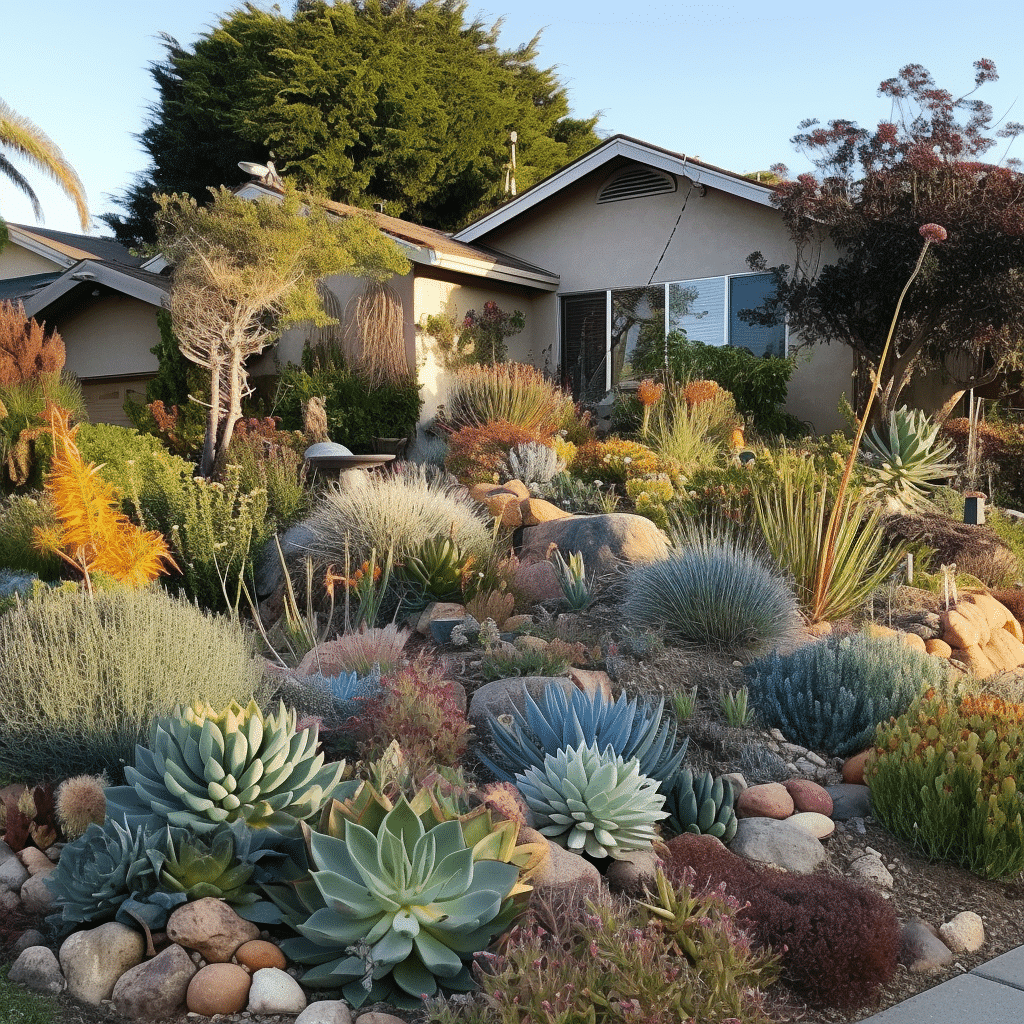.jpg)
Table of Contents
Introduction to Drought-Tolerant Landscaping
Drought-tolerant landscaping is an eco-friendly and practical way to create gorgeous outdoor spaces with minimal water. This modern landscaping method focuses on using plants, materials, and design techniques that can handle drought conditions and still look great.
Integrating native and drought-resistant plants in the landscape helps cut water consumption drastically. These plants are adapted to local climates and thrive in dry regions. Plus, adding efficient irrigation systems like drip irrigation and smart controllers reduces water use even more.
Furthermore, drought-tolerant landscaping promotes soil health and prevents erosion. Mulching with natural materials keeps moisture in the soil and stops weeds. Also, contours and terraces in the design retain rainwater, allowing it to seep into the soil slowly.
Using hardscape elements such as permeable pavements or gravel paths can reduce stormwater runoff. This helps to preserve water, instead of wasting it or causing erosion.
Moreover, drought-tolerant landscapes offer more benefits apart from conserving water. They’re a home for wildlife like birds, bees, and butterflies, boosting biodiversity in cities. Plus, these landscapes need less maintenance than traditional lawns, saving time and energy.
In conclusion, embracing drought-tolerant landscaping supports a sustainable future. We can make a positive impact on our environment while preserving water for future generations by implementing these practices.
The EPA says drought-tolerant landscaping can reduce outdoor water use by up to 50%.
Benefits of Drought-Tolerant Landscaping
Drought-tolerant landscaping offers many advantages. It helps conserve water, save time/money, reduce maintenance, and increase curb appeal. Plus, it promotes biodiversity! It also improves soil quality, prevents soil erosion, and reduces the need for chemicals.
Experts identified native plants suited to arid climates while still looking good. This led to the popularity of drought-tolerant landscaping. It’s a great way to conserve water resources and be environmentally friendly. Who needs a water hose when you can have a drought-tolerant landscape that’s as low-maintenance as your ex?
Planning and Designing a Drought-Tolerant Landscape
Planning and designing a drought-tolerant landscape requires careful thought. Consider these points to create an attractive, water-efficient outdoor space:
- Pick native plants – these are adapted to your area and need minimal water, saving you effort too.
- Set up efficient irrigation – drip, soaker hoses instead of sprinklers. Water goes directly to the roots, reducing evaporation and waste.
- Divide plants by water needs – group them together for efficient watering schedules and no over/under-watering.
- Think about hardscaping – mulch, gravel, permeable paving helps retain moisture, stop erosion, and lessens water usage.
For more success, view plants on a spectrum of drought-resistance. This lets you choose a range of plants that can cope in varied water scarcity.
Taller plants on the north side act as windbreaks. This stops evaporation and protects smaller plants from drying out.
Rainwater harvesting systems can also help in drought periods. Collect in barrels or underground tanks, and use for irrigation when needed.
By using these tips, your drought-tolerant landscape will save water and show off native plants’ beauty and resilience. With thoughtful planning and creative design, your outdoor space can thrive even with little water.
Maintaining a Drought-Tolerant Landscape
Creating and sustaining a drought-tolerant landscape needs careful attention and strategic planning. To successfully maintain your water-wise oasis, consider these key points:
- Choose native plants. These can thrive in arid conditions without compromising beauty.
- Prepare the soil. Amend it with organic matter to improve water retention and drainage.
- Use efficient irrigation. Drip irrigation or soaker hoses deliver water directly to roots, reducing evaporation.
- Mulch around plants. This retains moisture, preventing weed growth and insulating against temperature changes.
Not only are practical strategies important, but also fostering a mindset of conservation and responsible water usage. Sustainable practices can help conserve natural resources.
An example of the impact of drought-tolerant landscaping: In California, residents transformed their lawns with native succulents and ornamental grasses. This reduced the community’s water consumption and created a visually stunning neighborhood. This illustrates how effective maintenance of a drought-tolerant landscape can bring both environmental and aesthetic benefits, plus community pride.
From barren to beautiful, these landscaping projects show that, even in dry times, nature can still be a knockout.
Case Studies: Successful Drought-Tolerant Landscaping Projects
Drought-tolerant landscaping projects have become a successful way to battle water scarcity. These projects present innovative and sustainable approaches to landscaping that can even blossom in arid climates.
For instance, the ‘Green Oasis’ in California. It uses drought-tolerant plants, irrigation systems and permeable paving, cutting down water consumption while still looking beautiful.
Also, ‘Water-Wise Park’ in Arizona is an example. It uses xeriscaping techniques, like native plants and mulching, to minimize water usage. The park has shade structures and artificial turf to save water too.
The ‘Sustainable Campus’ program of a Texas university has drought-tolerant landscaping across its grounds. By replacing lawns with native grasses and harvesting rainwater, it has decreased its need for irrigation but still kept plenty of green spaces for recreation.
Want to get successful drought-tolerant landscaping? Here are some suggestions:
- Pick Native Plants: Use plants that grow in the region as they need less water.
- Use Efficient Irrigation: Install drip irrigation that targets plant roots, ensuring minimal water loss.
- Add Mulch: Place organic mulch around plants to keep the soil moist and stop weed growth.
- Improve Soil Quality: Add organic matter and aerate the soil for better water absorption and retention.
- Harvest Rainwater: Collect rainwater for watering the landscape during dry periods.
By following these tips, you can create landscapes that not only survive drought but also help environmental conservation. Join drought-tolerant landscaping and watch your garden grow with joy – saving water and looking great go hand-in-hand!
Conclusion: Embracing Drought-Tolerant Landscaping for a Sustainable Future
Text:
Drought-tolerant landscaping is key to a sustainable future. We can conserve water by choosing plants that need less. These plants are naturally resilient to pests and diseases, so there’s no need for harmful chemicals. Plus, they need minimal care and can survive in arid conditions.
Jennifer from California swapped her traditional lawn for native succulents and grasses. Her water usage dropped by over 50%. She also saw more wildlife in her garden – butterflies, bees, even hummingbirds! A truly picturesque setting, thanks to her drought-tolerant landscaping.


